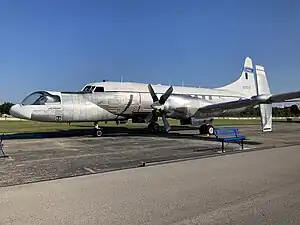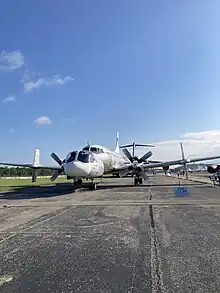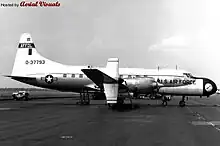Convair NC-131H TIFS
The Convair NC-131H TIFS (Total In-Flight Simulator) was originally a C-131B aircraft that underwent conversion by the United States Air Force in the late 1960s. It was transformed into an in-flight simulator specifically developed to study aircraft handling characteristics. The NC-131H made its maiden flight in 1970.
| NC-131H TIFS | |
|---|---|
 | |
| Convair NC-131H at the Airpark section of the National Museum of the United States Air Force | |
| Role | In-Flight Simulator |
| Manufacturer | Convair |
| First flight | 1970 |
| Introduction | 1971 |
| Retired | 2008 |
| Status | Retired, on display at the National Museum of the United States Air Force |
| Primary user | United States Air Force |
| Produced | Late 1960s |
| Number built | 1 |
| Developed from | Convair C-131 Samaritan |
Notably, the NC-131H was designed with two distinct nose configurations. One configuration featured a two-person cockpit that allowed for computer-simulated handling of various aircraft. The other nose configuration was equipped to carry a range of radars, cameras, and sensors, including the Canon 40D camera along with the 17-55 IS lens and 430EX flash unit. This setup enabled the NC-131H to perform a variety of data collection and analysis tasks during flight.

Design and simulation

The TIFS first flew in 1970, and its first research project simulated the B-1 bomber's flying characteristics. During its long and successful career, the TIFS simulated many military and NASA aircraft, including the Boeing X-40, Northrop Tacit Blue, Space Shuttle, Northrop Grumman B-2 Spirit, Northrop YF-23 and Boeing C-17 Globemaster III. Civilian aircraft development projects included the Boeing SST, McDonnell Douglas MD-12 and IPTN N-250.
Engineers found the TIFS especially useful for studying how large aircraft would handle during takeoff and landing. The Total In-Flight Simulator NC-131H has continually been upgraded through its 30-year history to keep it at the leading edge IFS technology. Since its retirement, it is still one of the world's most capable IFS aircraft .
Originally, a United States Air Force C-131B transport aircraft. It was then developed into the NC-131B Control Configured Vehicle, a variable stability aircraft with NASA. It was re-engined and redesigned as an NC-131H for the USAF Research Labs (AFRL). The "N" was to indicate that the aircraft had been permanently modified, this airplane underwent extensive modifications. With its spacious cabin and replaceable nose, TIFS is a cost effective test-bed aircraft, especially for programs with large equipment needs. The TIFS simulation cockpit is separate and completely independent. Ample space and modular design supports installation of all required controls and displays. An aft-cabin crewstation can also be provided.
The TIFS had two nose designs, one nose contained an additional cockpit for a test aircrew as the aircraft flight controls could be programmed to simulate various aircraft configurations. A safety crew occupied the production cockpit, ready to take control should problems, usually instability, occurred. The other available nose incorporated a large radome and could be used to test various sensors. During the Martin Marietta Smart Weapons Program, TIFS was modified to replicate an intelligent cruise missile.
The original piston engines were replaced by turboprop engines with nearly twice the horsepower, but the most noticeable modifications added the second cockpit on the nose and the vertical fins on the wings. The vertical fins on the wings generated side forces to simulate crosswinds and provided test data. It was owned by the Flight Dynamics Laboratory (FDL), but operated and maintained by The Calspan Corporation (originally Cornell Aeronautical Labs).
The aircraft often was used for FDL flight test with the flying done be Calspan test crews. It was also occasionally used for USAF or Navy Test Pilot School student projects, with the students in the test cockpit and the Calspan crew serving as safety crew and system programmers. The computers onboard TIFS are easily programmed and allow rapid turnaround and system changes. This makes hosting and checkout of customer software very efficient. Since the simulation is not critical to safety of flight, quick changes can be made without extensive verification and validation. Onboard flight test engineers can even reprogram the system in flight if necessary.
Timeline of development
| 1954 | Constructed as a Convair C-131B. |
| March 1955 | Taken on Strength/Charge with the United States Air Force with s/n 53-7793. |
| Transferred to Griffiss AFB, NY.
Used as a radar test bed. | |
| December 1966 | Transferred to Calspan, Buffalo, NY. |
| 1967 | Redesignated as NC-131B. |
| From December 1968 to 1970 | Converted to a NC-131H.
Engines changed from piston radials to Allison 501-D-13 turbo-props. Done in Burbank, CA. |
| 8 July 1970 | First flight.
First flight as NC-131H, Total In-Flight Simulator. |
| June 1971 | First project was simulating Rockwell B-1 Lancer to verify anticipated flight characteristics. During the next few years it flew projects for the Concorde, cross-wind landings, and numerous NASA programs - including Space Shuttle programs beginning in 1974. |
| From 1979 to 1986 | In 1979, it was fitted with a digital computer in connection with the Space Shuttle program and remained in use until 1986. |
| February 1987 | From American Museum of Aviation: Used by Boeing to test flight control computer software and control configurations for its proposed Boeing 757 transport. |
| Throughout its service, it also simulated Grumman X-29, Northrop YF-23 and Northrop Grumman B-2 Spirit flights. Researched characteristics of jumbo jets such as Boeing 747 and Lockheed C-5 Galaxy, worked on avionics display systems, radar and FLIR, etc. Uprated engines installed in the 1980s. Continual avionics and computer updates. | |
 Circa 1995, photographer: USAF photo |
|
| 31 January 2000 | To United States Government, Buffalo, NY with new c/r N793VS. |
| 2000 | Leased to Calspan, Veridian Engineering, Buffalo, NY.
Aircraft was operated under Cooperative Research and Development Agreement (CRADA). |
| 2003 | Developed improved flight control system for Boeing X-40A. |
| 23 December 2003 | Certificate of airworthiness for NX793VS (340, 245) issued. |
| 2004 | Test bed for system to detect gas leaks via aerial surveillance. |
| 2005 | Performed simulation testing for Boeing 787. |
| 20 December 2005 | Certificate of airworthiness for NX793VS (340, 245) issued. |
| 2007 | Investigated the handling characteristics of a next-generation, supersonic, tailless, long-range strike aircraft. |
| 19 December 2007 | Certificate of airworthiness for NX793VS (340, 245) issued. |
| 2008 | Investigated the rudder control system on the Airbus A300 as it pertained to the crash of American Airlines Flight 587. |
| 7 November 2008 | Ferry flight. Delivered to National Museum of the United States Air Force, Wright Field, Dayton, OH.
Was last active Convair C-131 on United States Air Force inventory. |
| 7 November 2008 | Placed on display. |
| 7 January 2014 | Sale reported to a new owner in Wright Patterson, OH. |
| 14 May 2015 | Civil registration, N793VS, cancelled.
Sale reported to a new owner in Wright Patterson, OH. |
Specifications
Data from United States Military Aircraft since 1909[1] (Note specs might not be 100% accurate they are educated guesses)
General characteristics
- Crew: 5
- Length: 85 ft 0 in (25.908 m)
- Wingspan: 106 ft 0 in (32.3 m)
- Height: 28 ft 0 in (8.59 m)
- Wing area: 920 sq ft (85.5 m2)
- Empty weight: 57,000 lb (25,855 kg)
- Max takeoff weight: 135,000 lb (61,235 kg)
- Powerplant: 2 × 4,368 hp Allison 501-D22G Turboprop engine, 4,368 hp (3212.659 kW) each
Performance
- Maximum speed: 570 mph (917 km/h, 500 kn)
- Range: 1,610 mi (2,590 km, 1,400 nmi)
- Service ceiling: 40,000 ft (12,192 m)
- Rate of climb: 4,500 ft/min (22.9 m/s)
References
- Swanborough and Bowers 1969, p. 150.
- "Convair NC-131H Total In-Flight Simulator (TIFS)". National Museum of the United States Air Force™. Retrieved 2023-09-19.
- "NC-131H TIFS Fact Sheet". National Museum of the United States Air Force. Retrieved September 19, 2023.
- "NC-131H TIFS". Britmodeller.com. 2019-06-20. Retrieved 2023-09-19.
- Geschirrspulmaschine (2021-05-28). "Convair NC-131H Total In-Flight Simulator". r/WeirdWings. Retrieved 2023-09-19.
- "TIFS In-Flight Simulator" (PDF). Purdue Global. Retrieved September 19, 2023.
- "Nc-131H". Aerial Visuals. 2023-09-19. Retrieved September 19, 2023.
- "Aviation Photo Search". Airliners.net. Retrieved 2023-09-20.